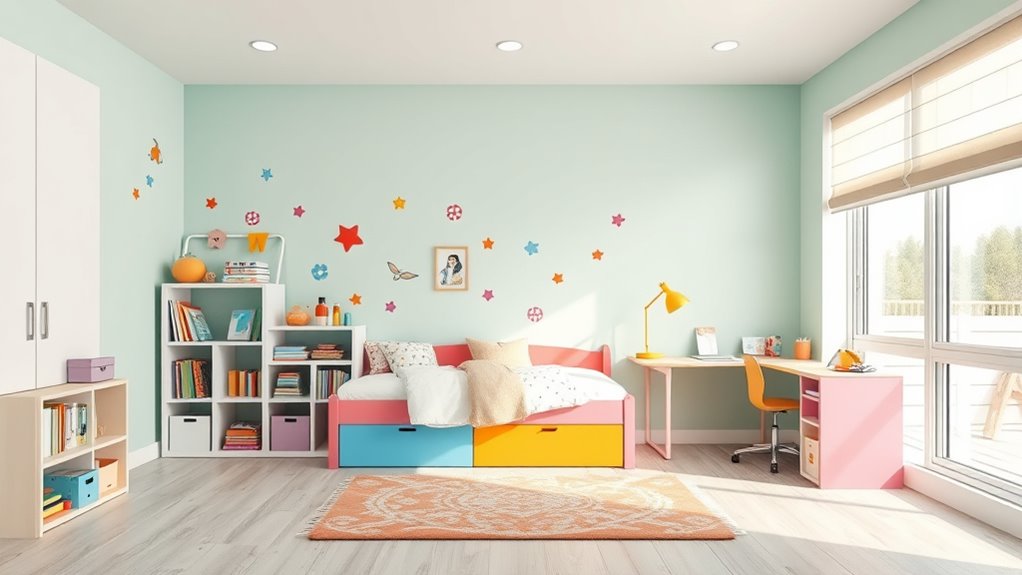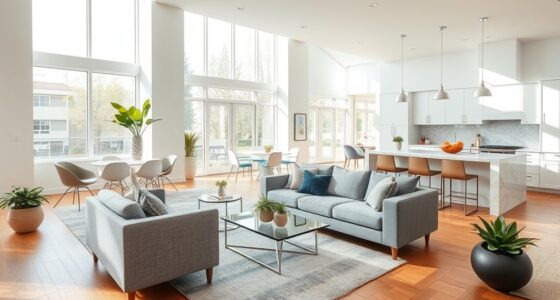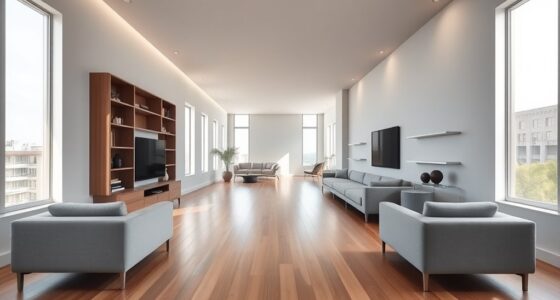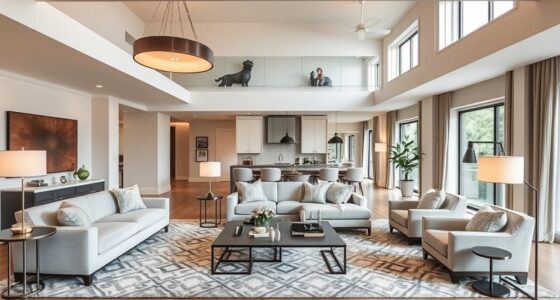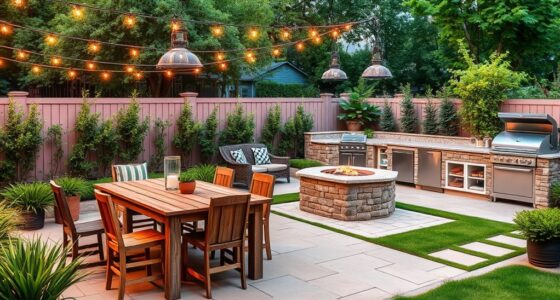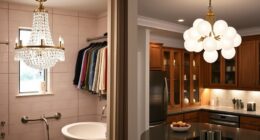Designing a kids’ room that grows with your child involves creating flexible zones for play, learning, and relaxation, using reconfigurable furniture and vertical storage to maximize space. Incorporate removable decor like wall decals, and choose versatile furniture with built-in storage to adapt as their needs change. By balancing practicality with playful touches, you foster independence and imagination. Keep the layout simple and easy to update, and you’ll set up a space that evolves naturally over time—learn more as you continue exploring.
Key Takeaways
- Create flexible zones for play, reading, and crafts that can be reconfigured as your child’s needs change.
- Incorporate vertical storage and multi-purpose furniture to maximize space and support growth.
- Use removable wall decals and adaptable decor to easily update the room’s theme and style.
- Design spaces that promote independence with accessible storage and dedicated activity areas.
- Plan for room evolution by choosing versatile furniture and flexible layouts that adapt over time.
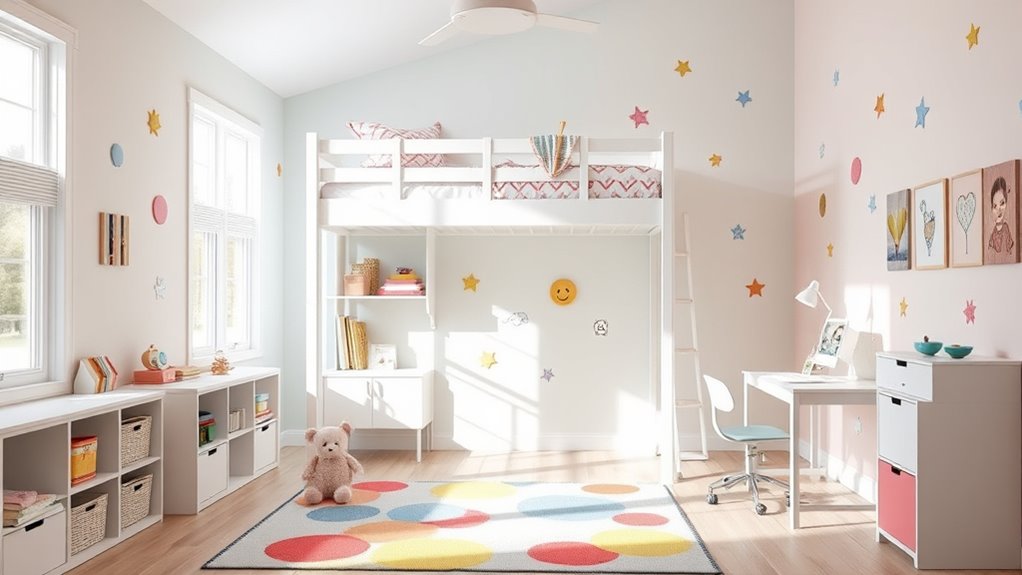
Have you ever wondered how to create a kids’ room that’s both fun and functional? Designing a space that adapts as your child grows isn’t as intimidating as it seems. The key lies in smart layout choices and easy-to-update decor. When focusing on playroom organization, think about storage solutions that keep clutter at bay while encouraging independence. Use multi-purpose furniture, like beds with drawers underneath or shelves that double as display areas. Baskets, bins, and wall-mounted cubbies help keep toys, books, and art supplies organized and accessible. This way, your child can quickly find what they want and learn to tidy up without fuss.
Create a versatile kids’ room with smart storage and adaptable decor for growing needs.
Incorporating wall decal ideas is a simple way to change the room’s vibe without a major overhaul. Stick-on decals are perfect for adding personality and color, and they’re easy to remove or swap out as your child’s interests evolve. Choose playful themes like animals, space, or favorite characters for a lively atmosphere. For a more subtle touch, opt for decals that mimic murals or patterns, which can add depth and style without overwhelming the space. Wall decals also serve a practical purpose—they can highlight a specific area, such as a reading nook or art corner, making it feel inviting and special.
When planning the layout, consider zones that serve different functions. A cozy corner with a small sofa or bean bags invites reading and relaxation, while a dedicated craft or homework area can boost focus. Keep the layout flexible so you can easily reconfigure as your kid’s needs change—maybe they’ll want a bigger workspace or more play space as they grow. Using vertical space creatively is also essential. Tall shelving units or wall-mounted storage keep the floor clear and give room for growth. You can even dedicate a section of wall for a chalkboard or whiteboard, encouraging creativity and organization.
Ultimately, a kids’ room that grows with your child balances practicality with fun. Focus on versatile furniture, clever storage, and adaptable decor like wall decal ideas. This approach not only makes the room easier to maintain but also creates an environment that sparks imagination and independence. With thoughtful planning, you’ll craft a space that evolves seamlessly alongside your child’s changing interests and needs, making it a true sanctuary for play, learning, and rest.
Frequently Asked Questions
How Can I Incorporate Educational Elements Into the Room Design?
To incorporate educational elements into the room design, you can create themed educational zones that promote interactive learning. Use wall decals, corkboards, or whiteboards for easy access to creative activities. Include bookshelves with a variety of books, puzzles, and educational toys. Design areas dedicated to science, art, or reading, encouraging exploration and curiosity. These zones make learning fun and adaptable as your child grows, fostering a love for discovery.
What Safety Features Should I Prioritize in a Growing Child’s Room?
Think of your child’s room as a fortress—you want it safe and secure. Prioritize child proofing essentials like outlet covers, cabinet locks, and corner protectors. Guarantee a safe sleep environment by choosing a sturdy bed and avoiding clutter that could cause falls. Regularly check for hazards as your child grows. By doing so, you create a space where your kid can explore freely while staying protected at every stage.
How Do I Choose Versatile Furniture for Different Ages?
When choosing versatile furniture, focus on pieces that adapt to your child’s changing needs. Look for adjustable furniture that can grow with them, like beds and desks with adjustable heights. Incorporate multifunctional storage solutions to keep the space organized as their belongings increase. These options maximize space and guarantee the room remains practical and comfortable, no matter their age, making it easier to update the room over time.
What Are Space-Saving Ideas for Small Kids’ Rooms?
To maximize space in small kids’ rooms, consider using multifuctional furniture like beds with built-in storage or fold-away desks. You should also utilize vertical storage solutions, such as wall-mounted shelves and hanging organizers, to free up floor space. These ideas help keep the room organized and functional, making it easier for your child to play, learn, and grow comfortably in a compact area.
How Can I Personalize the Room Without Frequent Redesigns?
To personalize your child’s room without frequent redesigns, focus on versatile decor updates and simple personalization tips. Use removable wall decals, themed bedding, and colorful accessories that reflect their personality. Incorporate adjustable storage solutions to keep the space flexible. You can also add a chalkboard or corkboard for changing artwork and notes. These ideas help keep the room fresh and personalized, making it feel special without the need for constant redesigns.
Conclusion
As you craft a kids’ room that evolves with your child, think of it as planting a sturdy tree—its roots grow deep, and its branches reach for new heights. With flexible layouts and clever storage, your little one’s space becomes a playground of endless possibilities. Remember, a well-designed room is like a comforting hug, nurturing growth and spark imagination. Soon, you’ll watch their space bloom as beautifully as their dreams.
